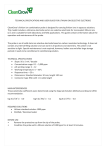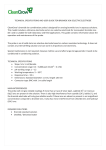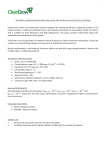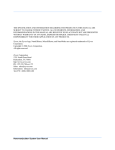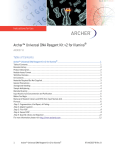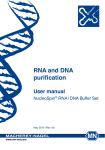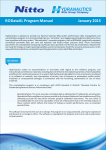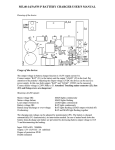Download TECHNICAL SPECIFICATIONS AND USER GUIDE
Transcript
TECHNICAL SPECIFICATIONS AND USER GUIDE FOR COPPER ION SELECTIVE ELECTRODE CleanGrow’s copper ion combination probe is designed for sensing copper ions in aqueous solutions. This model includes a reference electrode and an ion selective electrode for divalent copper ions (Cu2+) and is suitable for both laboratory and field applications. This guide contains information about the operation and maintenance of the probe. The probe is an all solid state ion selective electrode based on carbon nanotube technology. It does not contain any internal filling solution and can work in all positions and stored dry. The probe is not sensitive to light. Special maintenance is not required, however, before use and after large storage periods it needs to be conditioned in conditioning solution. TECHNICAL SPECIFICATIONS Slope: 25 ± 5 mV / decade Concentration range: 0.06 – 3,000 ppm (9.5 x 10-4 – 50 mM) pH working range: 2 – 7 Working temperature: 5 – 50°C Response time: < 30 s (>10 – 3000 ppm) < 5 min (<10 ppm) Dimensions: Standard diameter 8 mm, length 120 mm Connector type: BNC with 1 m cable length MAIN INTERFERENCES The probe cannot work in the presence of sulfide (S 2-), silver (Ag+) or mercury (Hg2+) ions. These ions must be absent from the solution. Bromide (Br-), chloride (Cl-), and ferrous (Fe2+) ions will give false negative results. The level of chloride and bromide ions relative to the level of copper ions in the sample is the determining factor for interference. These ions can only be present at maximum one tenth the concentration of copper ions. If they are present in higher concentration, they must be removed from the solution to get accurate results. If it is not possible to remove these ions, use the standard addition method to obtain the sample concentration. REQUIRED SOLUTIONS Copper standard solution 1000 ppm Distilled / Deionised water BEFORE USE • Remove the protective cap from the tip of the probe. • Condition the probe with a copper solution of 1000 ppm for 5 minutes and then condition with a low solution of 0.1 ppm of copper solution for 10 minutes. (The last step of conditioning is not necessary if you are going to measure concentrations above 1 ppm) MAINTENANCE AND STORAGE • Store in a cool, dry place. • Store and transport below 50°C • When finished measurements replace the protective cap of the probe. Do not leave the probe uncapped for long periods of time. • Do not hit or scrape the tip of the probe. MEASURING HINTS • All samples and standards should be at the same temperature for precise measurement. • Calibration and measurements times must be similar. • Always rinse the probe with deionised water and dry between measurements. Use a clean, dry tissue to prevent cross-contamination or shake the probe gently to remove remaining water drops. • Shake the probe slightly when immersed in solution to avoid air bubbles enclosed on the tip of the probe. DIRECT CALIBRATION 1) By serial dilution of the 1000 ppm standard, prepare 0.1 ppm and 10 ppm Cu standards. 2) Immerse the probe tip in the low standard solution for 5 minutes. When the reading has stabilised, record the mV reading. 3) After rinsing the probe with deionised water and blotting dry, immerse the probe tip in the high standard solution for 5 minutes. When the reading has stabilised, record the mV reading. Rinse with deionised water. 4) Take a sample reading with the same procedure. COPPER ION DETERMINATION BY STANDARD ADDITION (Using excel file). This procedure allows the determination of copper ions in complex matrices or when high interferences are present. All the volumes of the sample or standard added can be adapted to the user needs. The interactive excel sheet will allow you to modify your setting. Follow these steps: 1) Immerse the probe tip in 10 ml of unknown sample for 5 min. When the reading has stabilized, record the mV reading. 2) Add 420 µl of 1000 ppm Cu standard solution to the unknown sample to increase the copper concentration. Ensure the solution is mixed. Read the mV reading after 5 minutes of stabilisation. The addition of the standard should register a change of at least 20 mV. 3) Finally rinse the probe with deionised water, dry, and replace the protective cap. 4) Calculate the concentration using the excel document. Please take care to fill in the correct units in all the cells. CleanGrow Ltd., Unit 4, Euro Business Park, Little Island, Co. Cork, Ireland Tel: +353-21-4232000 E-mail: [email protected]



